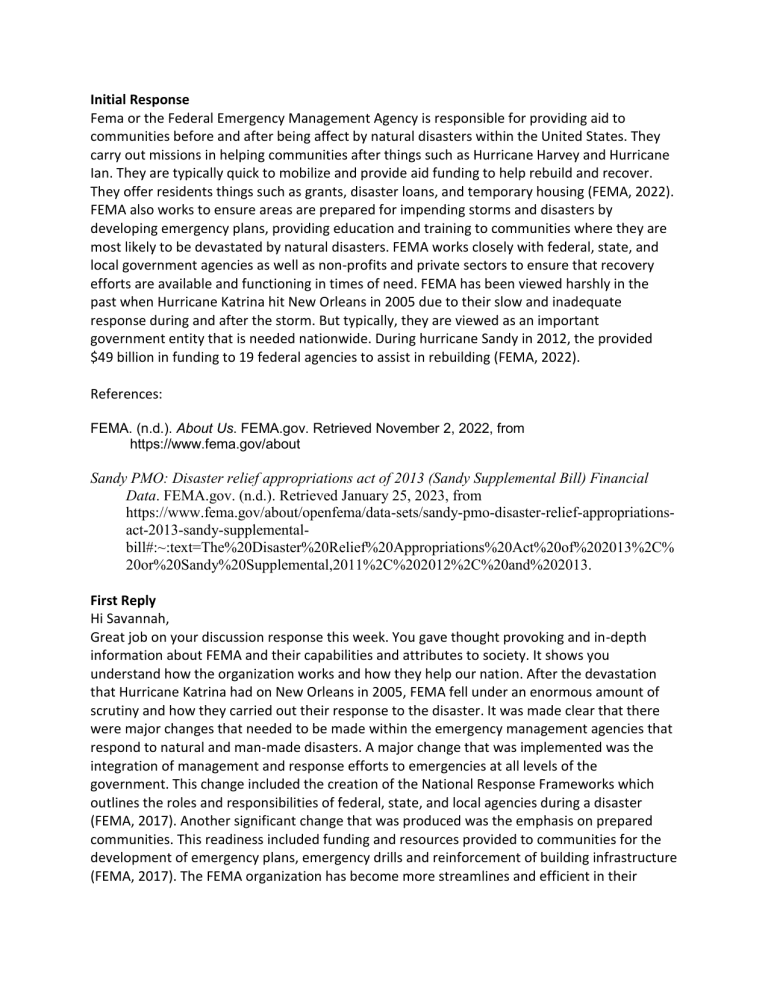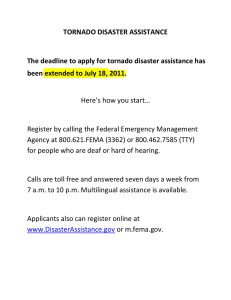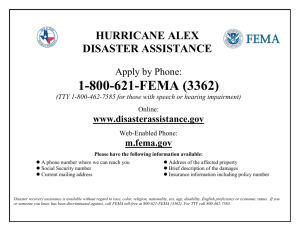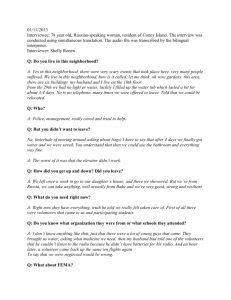
Initial Response Fema or the Federal Emergency Management Agency is responsible for providing aid to communities before and after being affect by natural disasters within the United States. They carry out missions in helping communities after things such as Hurricane Harvey and Hurricane Ian. They are typically quick to mobilize and provide aid funding to help rebuild and recover. They offer residents things such as grants, disaster loans, and temporary housing (FEMA, 2022). FEMA also works to ensure areas are prepared for impending storms and disasters by developing emergency plans, providing education and training to communities where they are most likely to be devastated by natural disasters. FEMA works closely with federal, state, and local government agencies as well as non-profits and private sectors to ensure that recovery efforts are available and functioning in times of need. FEMA has been viewed harshly in the past when Hurricane Katrina hit New Orleans in 2005 due to their slow and inadequate response during and after the storm. But typically, they are viewed as an important government entity that is needed nationwide. During hurricane Sandy in 2012, the provided $49 billion in funding to 19 federal agencies to assist in rebuilding (FEMA, 2022). References: FEMA. (n.d.). About Us. FEMA.gov. Retrieved November 2, 2022, from https://www.fema.gov/about Sandy PMO: Disaster relief appropriations act of 2013 (Sandy Supplemental Bill) Financial Data. FEMA.gov. (n.d.). Retrieved January 25, 2023, from https://www.fema.gov/about/openfema/data-sets/sandy-pmo-disaster-relief-appropriationsact-2013-sandy-supplementalbill#:~:text=The%20Disaster%20Relief%20Appropriations%20Act%20of%202013%2C% 20or%20Sandy%20Supplemental,2011%2C%202012%2C%20and%202013. First Reply Hi Savannah, Great job on your discussion response this week. You gave thought provoking and in-depth information about FEMA and their capabilities and attributes to society. It shows you understand how the organization works and how they help our nation. After the devastation that Hurricane Katrina had on New Orleans in 2005, FEMA fell under an enormous amount of scrutiny and how they carried out their response to the disaster. It was made clear that there were major changes that needed to be made within the emergency management agencies that respond to natural and man-made disasters. A major change that was implemented was the integration of management and response efforts to emergencies at all levels of the government. This change included the creation of the National Response Frameworks which outlines the roles and responsibilities of federal, state, and local agencies during a disaster (FEMA, 2017). Another significant change that was produced was the emphasis on prepared communities. This readiness included funding and resources provided to communities for the development of emergency plans, emergency drills and reinforcement of building infrastructure (FEMA, 2017). The FEMA organization has become more streamlines and efficient in their response efforts to all disasters. The implementation of these changes was in hopes of improving speed, effectiveness, and coordination in the face of disaster. Reference: FEMA. (2017). A Look Back: How FEMA Has Changed Since Hurricane Katrina. Retrieved from https://www.fema.gov/news-release/2017/08/28/look-back-how-fema-has-changedhurricane-katrina" Second Reply Hi Oliva, I really enjoyed reading your discussion response this week. I had several friends lose homes in the California Wildfires in 2017, so this one is close to home. I always knew that emergency organizations worked together in times of disaster, but I did a little more research on how the Red Cross and FEMA work closely with each other after reading your post. The American Red Cross and FEMA coordinate their efforts during disaster and recovery operations. According to the Government Accountability Office (GOA), the Red Cross primarily provides immediate disaster relief in services such as shelter, food, and emotional support where FEMA primarily provides long term recovery efforts, such as providing financial assistance and coordination in rebuilding of infrastructure within the community (GOA, 2018). The Joint Field Offices (JFOs) is a combination of the Red Cross and FEMA and serves as a central location to coordinate response efforts for various agencies during times of a disaster. According to the GOA report, the coordination efforts between FEMA and the Red Cross has significantly improved in recent years thanks to the beginning of the National Response Framework (NSF) and National Incident Management System (NIMS). With the creation of these agencies, there is a continued coordinated effort that creates an efficient and streamlined response to disaster. Reference: Government Accountability Office. (2018). Disaster Assistance: Improvements Needed in Coordination and Communication to Enhance the Effectiveness of the American Red Cross's Disaster Services. Retrieved from https://www.gao.gov/assets/700/695826.pdf



